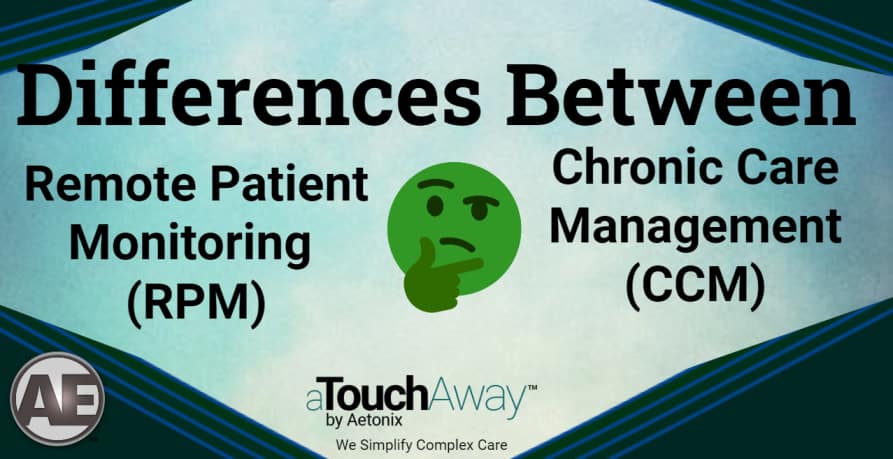Why They May Seem Similar
The most popular application for remote care by far is its use for chronic care. Both RPM and CCM can be billed in the same month, which is a testament to RPM’s supplementary nature to CCM. Thus, the two usually go together in the minds of people. As remote care is so commonly associated with chronic care, it is easy to forget that they have two different purposes. This post attempts to hash out the differences between Remote Patient Monitoring (RPM) and Chronic Care Management (CCM).
In the following table, the differences are discussed first, followed by the similarities.
DIFFERENCES |
||
| RPM | CCM | |
Purpose |
Has multiple purposes, that include chronic care management, principal care management (just 1 chronic condition), acute care, neonatal care, etc. | Has only one purpose, that is, to manage the care of those patients with two or more chronic conditions as designated by CMS. |
Requirement (With Clinical Staff) |
1) Initial set-up and patient education on use of equipment. 2) Device(s) supply with daily recording(s) or programmed alert(s) transmission, 16 or more days a month. 3) Remote physiologic monitoring treatment management services, 20 minutes or more of clinical staff/physician/other qualified healthcare professional time in a calendar month requiring interactive communication with the patient/caregiver during the month |
Chronic care management services, at least 20 minutes of clinical staff time directed by a physician or other qualified health care professional, per calendar month.
|
Care Activities |
Interpretation of the received data and interaction with patient on a treatment plan. |
Comprehensive care plan must be established. It must then be implemented, revised, or monitored on a monthly basis.
It can involve the following: · Systematic assessment of the patient’s medical, functional, and psycho-social needs.
· System-based approaches to ensure timely receipt of all recommended preventive care services.
· Medication reconciliation with review of adherence and potential interactions.
· Oversight of patient self-management of medications.
· Coordinating care with home- and community-based clinical service providers. |
Min. Monthly Reimbursement |
($52 for non-facility/ $32 for facility) +$64 for monitoring | $42 for non-facility/ $32 for facility |
Complexity of Cases |
Does not have separate codes for medium to high complexity cases. | Has separate codes for medium to high complexity cases. |
Possibility of Increments |
In increments of 20 minutes. | In increments of 20 minutes, however if 60 minutes will be required a month, it is encouraged to bill a complex care code that starts at 60 minutes monthly. |
Requirement(Without Clinical Staff) |
Collection and interpretation of physiologic data digitally stored and/or transmitted by the patient and/or caregiver to the physician or other qualified healthcare professional, qualified by education, training, licensure/regulation (when applicable) requiring a minimum of 30 minutes of time, each 30 days | Chronic care management services, provided personally by a physician or other qualified health care professional, at least 30 minutes of physician or other qualified health care professional time, per calendar month. |
24/7 Access to Care |
No | Yes |
| SIMILARITIES | ||
Initiation |
For new patients or patients not seen within 1 year prior to the commencement of CCM, Medicare requires initiation of CCM services during a face-to-face visit with the billing practitioner. Has to be initiated by an Annual Wellness Visit, Initial Preventive Physical Exam, etc. | |
Staff Involved |
Physicians, Qualified Health Professionals, Clinical Staff | |
Billing Cycle |
Monthly | |
Supervision |
General Supervision | |
Patient Consent |
Required | |
Location of Patient |
Anywhere outside of the hospital. Does not have to be in an originating site, as it’s typically the case with telehealth services. | |
Cost Sharing |
20% patient copayment (if there is no supplemental insurance) | |
From the table above, one can appreciate how it is easy to meddle RPM and CCM together, given that the similarities section is almost as long as the differences section. But in reality, one is a program (CCM), the other is more like a tool (RPM) which can be used in other programs besides CCM. The healthcare organization’s need should always dictate what to implement, and if it is necessary to use the two together.
Remote patient monitoring is tailor made to boost the clinical efficiency and outcome of chronic care cases. In today’s age, one cannot simply rely just on telephonic communication any longer, or afford to not receive daily readings from the patients. Hence Remote Patient Monitoring is a natural and essential component for any successful Chronic Care Management Program. But should you only consider RPM for chronic care programs? Not at all. There are many examples of acute care programs made successful by RPM. Pre and post-surgery coordination, and temporary rehabilitative care are very popular use cases for RPM.
I hope you found this article useful is discerning the differences between CCM and RPM. If there are any questions, do not hesitate to reach out to me at rahat.haque@aetonixsystems.com. Also make sure to follow us on our Social Media channels so you can be up to date on all our latest publications.

